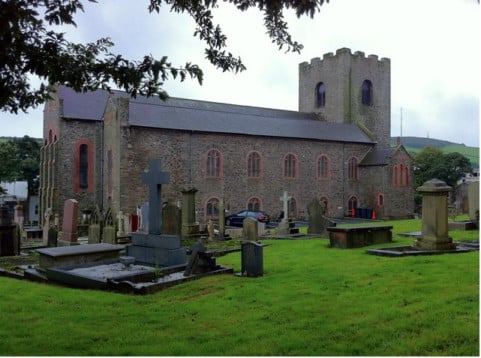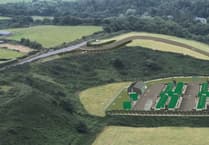In July the Isle of Man will again see its historic links with the Cumbrian port of Whitehaven temporarily revived thanks to sailings by the classic steamer Balmoral. However, an older symbol of those links is St George’s Church in Douglas, which is said to have been modelled on St James’ Church in Whitehaven, a building claimed by the architectural historian Nikolaus Pevsner as having ’the finest Georgian church interior in Britain’. SIMON ARTYMIUK looks at the story of its building
-----------------------------
At the beginning of the 18th century, the reforming Bishop of Sodor and Man Thomas Wilson was concerned at the lack of church provision in the growing port of Douglas, which had grown from just a string of cottages beside the mouth of the River Dhoo-Glas to a town with a population of around 800.
In 1708 Wilson therefore had the chapel of St Matthew’s built in the community’s marketplace beside the harbour’s North Quay.
The Bishop often denounced the island’s developing smuggling or ’running’ trade from the pulpit but it continued to grow unabated in the first half of the century so that by 1760 the port had swelled into a packed collection of merchants’ mansions and poorer residents’ cottages and cabins crammed cheek by jowl along a series of narrow and crooked streets - some said the better for the smugglers to evade the revenue officers should the British crown decide to launch a raid.
The population had by then swelled to 2,800 and the wealthy merchants were clearly tired of having to jostle for seats in the now wholly inadequately sized chapel, which during the day also doubled up as a schoolroom.
They therefore arranged a meeting with Bishop Wilson’s successor, Mark Hildesley, to suggest that what was needed was a new, roomier - and more exclusive - church with a greater degree of elegance befitting persons of their wealth and social aspirations.
Research undertaken by island historian CW Gawne indicates that the prominent citizens asking for a new church included Philip Moore, Hugh Cosnahan, William Quayle, Peter John Heywood (who had risen to the position of Deemster and would shortly inherit the Nunnery mansion and estate), John Christian, James Oates, Richard Joynes, John Joseph Bacon, John Finch, John Clarke, Robert Black and Robert Caesar.
These prominent citizens wanted the St Matthew’s Chapel site sold and the money raised reinvested in a new church - and also suggested that the chaplain’s stipend and his expenses as schoolmaster (poor man) could be appropriated to the same worthy cause!
However, in the end St Matthew’s survived into the 19th century and instead the Bishop suggested that the money for a new church should be raised by subscription.
Philip Moore donated a site called Oates Land (a then exposed plot on the hilltop above the harbour, reached by a rough track) and so many people subscribed to the new church project that by 1761 funds promised had reached £712, while others made one-off donations. This was despite it being a turbulent time of the Seven Years War.
So that more subscriptions could be collected, a board of trustees was appointed - one was Dr Richard Betham of the Hague mansion in Onchan, the crown’s collector of customs and later Captain William Bligh of the Bounty’s father-in-law.
The new church was actually to be regarded as a chapel of ease as it was in the parish of (Old) Kirk Braddan.
The trustees therefore had the whole responsibility of ordering the stone and timber and employing workmen for the project.
An overseer was also appointed whose name does not seem to have survived. Tradition states that he was sent over to Whitehaven - the nearest English port to the Isle of Man and also then regarded as the third most important port in the land after London and Bristol, due to its coal trade with Ireland plus its tobacco, rum and sugar trade with the American colonies - to make drawings of the recently built St James’s Church there to form the basis for the new Douglas chapel’s design.
Actually, though, it may be that Peter John Heywood was the driving force in this, as in 1762 he married Elizabeth Spedding of the Summergrove mansion close to Whitehaven.
Her father was James Spedding, the wealthy Sir James Lowther’s agent, and she was also granddaughter to none other than Carlisle Spedding, the prominent mine engineer actually credited with designing Whitehaven’s St James’s Church.
The stone for the Douglas chapel was quarried close by at Bank’s Howe and Nunnery Howe, while mortar was made using limestone burnt in a kiln on-site.
However, to obtain enough timber in that time, when much British wood was going into making ships for the Royal Navy, a schooner was specially chartered and sent all the way to the Baltic port of Riga in Latvia.
Work went on for four years, and the new chapel was actually half-roofed with slate, when first the money ran out and then the shock announcement of the Revestment of sovereignty over the island in the British crown plunged all the merchants involved in the ’running trade’ into the doldrums.
As the crown officers and soldiers moved in, many left to pursue their trade elsewhere, to such places as Ireland, Guernsey and even the Faroe Islands, while others who remained felt uncertain of the future and, with plummeting property prices and island streets losing their former bustle of customers, withdrew their offers of funds for the chapel.
However, soon the officers moving in from ’across’ were followed by English and Scottish gentry of straitened means who found the island a cheap place to live, free of their creditors.
Soon the Douglas social scene began to revive - as did the need for the abandoned new chapel to be completed. No doubt the success achieved by the Methodists in making island converts in the 1770s - with the preacher John Crook visiting in 1775 and then John Wesley himself visiting in 1777 and again in 1781, both via the regular government sailing packet service from Whitehaven established in 1774 - helped to sharpen Anglican clerics’ minds.
Not that they themselves had been idle - in his last years Bishop Hidesley had masterminded the translation of the Bible into Manx as Yn Vible Casherick, with Philip Moore taking part in the project.
It was taken to Whitehaven for printing on the press of J Ware & Son, who also printed the Cumberland Pacquet, which became the first newspaper covering the island, but the Bible translation was almost lost in 1771 when the ship on which the Rev Dr Kelly was taking it ’across’ was wrecked near the Cumbrian shore. He saved it only by holding the manuscript above the water for five hours until he was rescued. The first printed copy arrived in the island in November 1772 - and Bishop Hidesley died nine days later.
It was therefore a new bishop, Richard Richmond - put forward by the 3rd Duke of Atholl - who revived the Douglas chapel project in 1775.
He appointed new trustees to reopen the subscription lists and to help clear the outstanding debts he extended the appeal to the wealthy of Britain at large.
He must have been well connected as three archbishops, 13 bishops, the Duke and Duchess of Atholl (still lords of the manor in the island despite Revestment), six other dukes, six earls and numerous notables contributed £418 1s 0d of the £800 raised to restart the building work in 1776.
This was despite Britain again being at war, this time with its American colonies. Not only was the trade of Whitehaven with the tobacco merchants of Virginia and Maryland ended but privateers became active in the Irish Sea, culminating in 1778 with Scots-born John Paul Jones - founder of the US Navy - fighting a sea battle off the Manx coast near Point of Ayre and then trying to burn down Whitehaven by setting fire to its coal ships.
Luckily one of his crewmen betrayed him and raised the alarm.
Despite this turmoil, the 4th Duke of Atholl donated an engraved silver communion service for use in the new Douglas chapel in 1777 and three years later it looked like the building was about to be completed at last - when another crisis hit. Bishop Richmond suddenly died and it was found that the money the chapel trustees had collected and handed over to him had not been clearly demarcated from his private finances. Despite this they agreed to carry on funding the project until the muddle was sorted out, though they did charge interest.
The building - with additional architectural refinements from those designed in the 1760s - was opened in 1781.
As an additional way of raising funds pews were leased to well-to-do families for periods of seven years, with John Ware & Son printing the advertisements for this. There were only a token number of seats for the poor in this church.
The church’s interior, with its side galleries on pillars, with columns of a different order then extending to the ceiling, owes a clear debt to St James’s in Whitehaven. These details, along with the Venetian window behind the altar, are ones also found in a number of 18th-century Cumbrian churches, such as St Andrew’s in Penrith (built in the 1720s), St Mary’s in Wigton (built in 1788) and St Cuthbert’s in Carlisle (rebuilt 1778). These churches also have two tiers of windows along their sides like St George’s.
The organ, funded by a separate subscription, caused a sensation in the Isle of Man, where West Gallery singers with fiddle accompaniment were the norm.
It was a second-hand one bought from Dublin - the story often told is that it was the one the composer Handel played to accompany the first performance of his oratorio Messiah, but this appears to be a myth - and we read that such was the novelty of such music that farmers would stay in the town overnight so they could attend service on Sunday.
An additional attraction was a soldier of the English garrison with a fine solo voice.
The exterior of the church seems curiously plain compared with the Cumbrian ones listed above - particularly the tower. However, the tower bears a striking resemblance to the one at Burgh by Sands beside the Solway Firth near Carlisle - a tower with a base built in the 14th century from rubble ’salvaged’ from the nearby remains of Hadrian’s Wall, so perhaps the builders of St George’s were trying to give an heir of antiquity to their new building.
The Cumbrian churches St George’s resembles have, like the Douglas church, all undergone changes since they were built but still carry Grade 1 or 2 listed status under the UK system.
It seems curious that despite its interesting history and elegant interior, St George’s remains unregistered by the Manx authorities, despite its use at important civic events.
-----------------------------
St James Church in Whitehaven is said to have been designed by Carlisle Spedding (1695-1755), who joined the estate of the Lowther family (who owned and developed Whitehaven, turning it into a major port for trade with the American colonies, as well as shipping coal to Ireland) in 1710 as Assistant Colliery Steward to his brother, John Spedding.
He was appointed Colliery Steward in 1730 and gained a national reputation as one of the leading mining engineers of the 18th century after excavating one of the first undersea mine tunnels in Britain.
He designed St James Church in 1752-53, possibly basing his designs on St Andrew’s Church in Penrith. This in turn has an interior resembling St Martin-in-the-Fields Church in Charing Cross, London, the first church specifically designed for the 18th century Protestant style of worship, where the sermon from a high pulpit was the most important element. Pattern books produced at the time meant its interior was widely copied in Britain and America.
Carlisle Spedding was killed in a pit explosion at Whitehaven on August 8, 1755.
He was grandfather of Peter John Heywood’s wife Elizabeth, mother of Manx Bounty sailor Peter Heywood.

.jpeg?width=209&height=140&crop=209:145,smart&quality=75)



Comments
This article has no comments yet. Be the first to leave a comment.